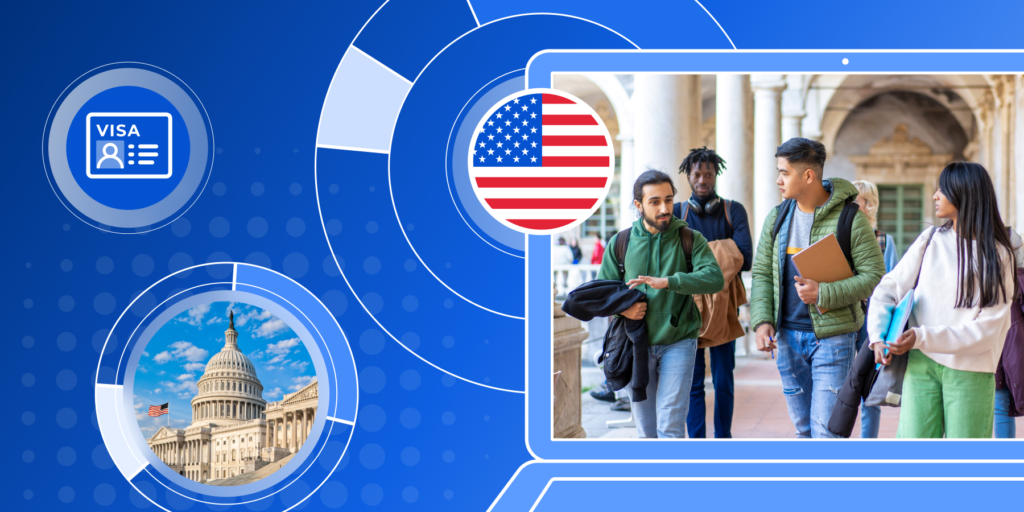As the international education sector weathers geopolitical and structural change, the persistent level of interest in studying in the US illustrates the resilience of international students and the academic institutions that support them. During the first half (H1) of the 2025 fiscal year,1 the United States government issued nearly 89,000 F-1 student visas.2 While this total was slightly lower than the H1 totals of the previous three years, it remained above pre-pandemic levels.
How have incoming student populations shifted? Below, we’ll analyze data from the U.S. Department of State to identify the latest international student demographic trends. Discover where demand grew and softened, and what strategies American institutions can use to adapt to this new landscape.
Key Insights at a Glance
- Total F-1 student visa issuances in H1 FY2025 dipped 15% compared to the same period in 2024. However, H1 has historically accounted for only one in every four F-1 visa issuances in previous full fiscal years.
- F-1 visa issuances to Indian students dropped by 44% in H1 of 2025 compared to H1 of 2024, mirroring trends occurring in other major Anglophone destinations.
- Just over 11,000 Chinese students were issued an F-1 visa over the first half of 2025, returning to similar levels as 2022 and 2023.
- Year-over-year, Vietnamese students were issued 20% more F-1 visas in H1 2025, becoming the third-largest student population by F-1 visas issued over this time period.
Total Number of F-1 Visas Issued During H1 Dips
Across most major destinations, new student visa numbers fell in 2024 compared to all-time highs set in 2023. While the US remained the most resilient, this overall slowdown is expected to continue to impact student flows in 2025. Looking at mid-year 2025 data, US government data shows that almost 89,000 international students were issued an F-1 student visa during H1 2025. The chart below illustrates how this total compares to the previous seven fiscal years:
In H1 2025, half-year F-1 issuances fell below 100,000 for the first time in four years. However, total issuances for this time period still remained well above pre-pandemic levels.
Because most students start classes in the fall, fewer F-1 visas are generally issued in the first half of the fiscal year. In fact, H1 has historically accounted for only one in every four F-1 visa issuances over previous full fiscal years. H1 also hasn’t historically correlated with full-year performance, as both 2022 and 2023 had contracting year-over-year H1 issuances but higher full-year totals.
That’s because June and July are typically the busiest months of the year. While June and July 2025 data is not yet available, this issuance data will likely be shaped by the American government’s temporary suspension of all new student visa appointments, which halted many applications in late May and much of June. This pause may, in turn, lead to processing bottlenecks. Some academic institutions in the US are already advising their enrolled, incoming students to submit their visa applications promptly and request expedition of their application to avoid missing the start of the academic year.3
January to May 2025 F-1 Visa Issuances Relatively Steady Year-Over-Year
Over the first five months of the 2025 calendar year, F-1 visa issuances remained fairly similar to issuance levels from 2023 and 2024:
No monthly total issuances in 2025 exceeded the same month’s totals in both of the previous years. Although February 2025 came close with 6,800 issuances, it was just short of the 7,100 issued in February 2023, yet exceeded the February 2024 monthly total. April 2025 also surpassed the April 2024 total, though it was 4,000 short of the 2023 high point.
In May, the upswing in issuances in advance of the fall intake begin. Total issuances in May 2025 nudged past 2023’s monthly total, despite being an abbreviated month due to the pausing of new student visa appointments. However, 2025’s student visa issuances were 21% lower than 2024’s.
As we look to the summer, and how issuance trends may evolve, it’s worth noting the government’s pause of student visa interviews lasted almost a month, with regular scheduling of student visa application interviews beginning again after June 26.4 This re-opening was accompanied by instructions to U.S. consular officers to expand social media vetting procedures for student visas. Moving forward, student visas will likely take longer to review, both as officials adjust to the new processes, and due to the more detailed review.
As the directive guiding this process noted, “Posts should consider overall scheduling volume and the resource demands of appropriate vetting; posts might need to schedule fewer FMJ [student] cases than they did previously.”5
To help ensure international students can start classes on time, institutions should include key factors like current visa processing times in their communications with prospective students. This can help students understand the importance of preparing their visa application early, and help them build a realistic application timeline.
India Remains Largest Incoming International Student Population in the US in H1 2025
As the two largest student populations in the US, China and India play a key role in shaping student bodies on campuses across the US. Let’s take a closer look at their F-1 visa issuance trends over the first half of the fiscal year:
The number of F-1 student visas issued to Indian students dropped by 44% year-over-year to 14,700, continuing a downward trend that started in H1 2024. Notably, Indian student demand has softened among most other major Anglophone study destinations. Visa demand from Indian students dropped by nearly 20% between the 2022/23 and 2023/24 academic years in Australia, and that trend is expected to persist in 2024/25 based on H1 fiscal year data. Meanwhile, Indian students were issued 57% fewer Canadian study permits in calendar year 2024 versus 2023.
Over the full 2024 fiscal year, 86,000 US student visas were issued to Indian students, versus 83,000 to Chinese students. If current trends continue, it’s possible Chinese students will become the largest incoming international student population in the US for the first time in four years. In H1 2025, US student visa issuances to Chinese students dropped 24% year-over-year to just over 11,000. However, the H1 2025 total is similar to 2022 and 2023 totals over the same period, suggesting a return to more stable levels of demand.
Over the 2024 fiscal year, 42% of new international students in the US were from India or China. While a sizable proportion of the international student body, this percentage is shifting: in the previous fiscal year, India and China received 49% of all issued F-1 visas.
Top 20 Student Populations During the First Half of 2025
As India and China now account for a smaller share of American student visas, the overall international student body in the US is diversifying. A closer look at the 20 largest incoming student populations over H1 2025 highlights the key contributors to evolving American campuses:
New student populations from almost half of the top 20 markets grew in H1 2025 compared to the previous year. Interestingly, many of the larger international student populations among this group saw fewer new incoming students join them compared to 2024, while student populations from several emerging populations grew.
For example, students from Zimbabwe were issued 162% more visas in H1 2025 versus H1 2024. The US has become the third-most popular destination for Zimbabwean students after South Africa and the United Kingdom, bolstered by these students’ increased interest in higher education (especially at the postgraduate level) and access to partnerships like EducationUSA’s Opportunity Funds.6 Zimbabwean students graduate from secondary school into a job market with a high youth unemployment rate (30.1% in 2024)7—for many, higher education is a path to a career outside of the informal sector, one with better pay and job security.
Growth over this first half of the fiscal year was global: in addition to Zimbabwe, whether hailing from Bangladesh, Colombia, Germany, Pakistan, Saudi Arabia, or Vietnam, students from many regions around the world were issued more US student visas in H1 2025 year-over-year.
With strong academic achievement, expanding middle-class wealth, and a keen interest in global opportunities, Vietnamese students are shaping the international education landscape more than ever.
How American Institutions Can Build the Next Generation of Leaders
Postsecondary education in the US has a long history of excellence and high demand among international students. But with seven of the US’s top eight student populations experiencing downturns in H1 2025, global student recruitment is more important than ever as diversity helps institutions mitigate geopolitical tensions. In today’s sector, achieving recruitment success may mean customizing existing strategies to attract the brightest minds from emerging student populations.
To guide prospective and incoming international students through a sector landscape that’s changing rapidly, institutions can offer several helpful supports. Admissions teams can ensure students understand shifting intake guidelines and government policy by providing accessible, data-driven communications that inform students about what’s changed and how those changes may affect their journey.
Understanding current student motivations through targeted outreach or audience surveys can also help your team effectively guide students from application to arrival. And, where possible, speaking publicly to how international students can thrive on your campus and community—and go on to make it a smarter, and more innovative and exceptional place—can show these future leaders that they continue to be welcomed in the United States.
ApplyBoard’s platform empowers academic institutions to engage with global student populations. With real-time data and expansive market insights, we help institutions adapt to shifting student preferences. As demand evolves, leveraging ApplyBoard’s expertise can ensure your institution stays ahead of the curve—attracting the right students, in the right fields, at the right time.
Contact our team to take your student recruitment strategies to the next level.
Subscribe to ApplyInsights
Sign up for the latest insights on international education.

About the ApplyInsights Team
FOOTNOTES:
1. All student visa data in this article is sourced from the U.S. Department of State. American fiscal years run from October of the previous year to September of the given year, making H1 of the fiscal year October through March. Throughout this article, all given years refer to a fiscal year, not a calendar year, unless stated otherwise.
2. As F-1 student visas are the most common visa status used by international students in the United States, we’re limiting our analysis to that visa type. Here and throughout the article, “student visa” refers to an F-1 (academic) visa. The American government also issues J student exchange visas and M student visas for non-academic study or vocational study and training.
3. University of Wisconsin–Madison – International Student Services. “Visa Appointments Resume after Three-Week Suspension.” Updated June 18, 2025.
4. NAFSA, “Student and Exchange Visitor Visa Appointment Capacity and DOS Guidance on Expanded Social Media Screening.” July 1, 2025.
5. Humeyra Pamuk, Reuters. “Trump administration tightens social media vetting for foreign students.” June 18, 2025.
6. Nyashadzashe Ndoro, Nehanda Radio. “Zimbabwean students flock to US universities, numbers rise by 6.6%.” Nov. 19, 2024.
7. Zimbabwe National Statistics Agency, “2024 Third Quarter Labour Force Survey Report.” Sept. 2024.



